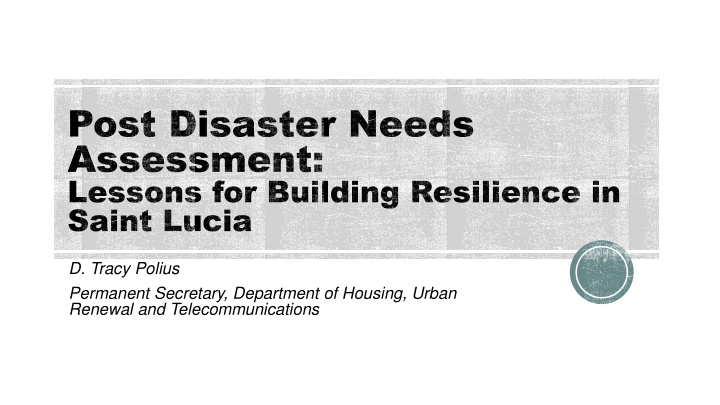



D. Tracy Polius Permanent Secretary, Department of Housing, Urban Renewal and Telecommunications
Over the last 25 years, Saint Lucia has Event Year Dam./L % of GDP experienced average annual historical oss losses of about USD 40 million (US$ M) Source: WB analysis of DesInventar and CDB Christmas 2013 $99.8 8.3 Trough Costs to Saint Lucia associated with Hurricane 2010 $336.0 43 Climate Change Impacts have been estimated at US$59 m (PPP) in 2010 and Tomas are estimated to rise to US$541m (PPP) Hurricane 2007 $18.8 1.6 by 2030 . (Source DARA Climate Vulnerability Monitor) Dean Hurricane 2004 $2.6 0.24 In long term, Saint Lucia would have to set • aside about .5% of current GDP each Ivan year (USD 7.6 million) for earthquakes and Trop. Storm 2002 $20.0 2.2 windstorms. (Source CCRIF) Lily
Hurricane Tomas December 2013 Trough
Government Actions Assessment Methodology Initial response coordinated by NEMO, DaLA methodology developed by UN- Ministry of Infrastructure and other ECLAC and expanded by GFDRR agencies Broadly reflects damage to assets and loss Coordinated the Damage and Loss to economic flows Assessment (DALA) with technical assistance from the World Bank. Summarizes approximate total macroeconomic impact Coordinated the Post Disaster Needs Assessment in collaboration with UNDP, Reconstruction needs are included as a OECS and UNECLAC financing element with a view to building Prioritization of reconstruction of key back better infrastructural projects
Hurricane Tomas December 2013 Trough Education Water, Agriculture and Health Electricity and Water, 13% 1% Telecoms Electricity Agriculture 7% &Telecom Tourism 29% 13% 2% Housing 4% Commerce 1% Transportation Infrastructure 23% Tourism 11% Education & Health Commerce Housing Transport 2% 4% 18% 72%
Hydro-met events typically impact the country significantly Transportation sector significantly affected by the events Water sector highly vulnerable Map overlay shows areas of high rainfall coincide with areas of high poverty Limited level of redundancy in the provision of key services – water and electricity
Resilient Recovery and Reconstruction Improve Resilience through Disaster Risk Reduction Measures Risk Identification and Assessment Strengthen Disaster Risk Preparedness Disaster Risk Financing Strategy
Recovery measures – housing, schools, roads Implementation of structural measures to restore road network, improve drainage and slope stabilization Implementation of projects to build in redundancy into water supply, improve water quality and watershed management Policy decision on diversification of electricity supply Technical Assistance Programme aimed at risk identification, risk mapping, valuation of assets. TA Programme to develop risk financing strategy
Recommend
More recommend